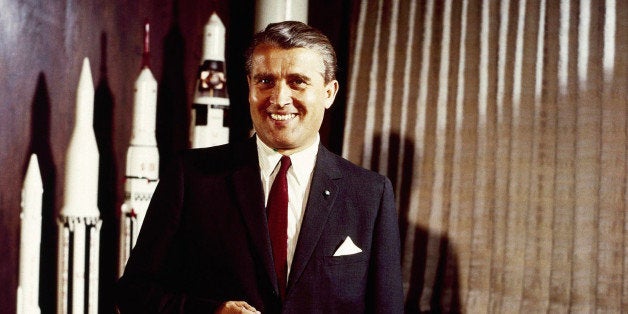
WASHINGTON -- They lived within our borders for years, thousands of miles away from the lives they helped ruin. Serving as cornerstones of America’s post-World War II scientific advancement, they worked for NASA and helped develop our rockets, quietly burying their horrific pasts under accolades from the U.S. aeronautics community.
These were America’s Nazi transplants: scientists, academics and thinkers who were employed by the U.S. government, despite résumés full of horrid atrocities. And, as New York Times reporter Eric Lichtblau reveals in a new book, their genius was considered so valuable that Washington worked to protect them from the consequences of their horrible pasts.
This information, revealed in detail for the first time in Lichtblau’s book, “The Nazis Next Door: How America Became a Safe Haven for Hitler’s Men,” traces the legal battles and moral struggles surrounding the country’s clandestine Operation Paperclip program, which brought former Nazi scientists to America to bolster the nation’s scientific community.
Among the Third Reich transplants was the late Wernher von Braun, considered a legendary NASA space scientist who, in his previous life, oversaw Hitler’s Mittelwerk slave labor factory and helped the Nazis develop missiles. Another was the late -- and controversial -- Dr. Hubertus Strughold, who is still considered the “father of space medicine." Strughold is the former namesake of a prestigious Space Medicine Association award who, in his Nazi days, helped orchestrate science experiments on human guinea pigs at the Dachau concentration camp.
The program itself isn’t a new revelation. Aspects of the operation -- which was run primarily by the Office of Strategic Services, the World War II-era precursor to the CIA -- were reportedly disclosed as early as 1946. Journalist Annie Jacobsen wrote extensively on the secret affair earlier this year, and news reports and investigative projects have discussed the presence of Nazi war criminals who reaped benefits within U.S. borders.
But what Lichtblau's book illustrates for the first time is the politics of the Paperclip operation, including pressure from the Reagan White House to dismantle its own Justice Department's investigations into the war criminals’ pasts. In this way, the U.S. became a refuge for some of Hitler’s most notorious cronies.
Lichtblau reveals in the book that not all of Washington had collectively agreed to ignore the disturbing pasts of some of its chief scientific leaders. Quite the contrary -- even while the White House and its intelligence agencies were quietly employing some of the Nazis’ best minds in the nation’s scientific circles, mostly in a Huntsville, Alabama, military community, the Justice Department was secretly building cases against them.
A covert investigative team, Lichtblau writes, began gathering evidence against the German transplants in the early 1980s, despite pushback from officials over investigating the scientists, who were well-established at this point.
The team caught its break in the form of the late Arthur Rudolph, the German who is still hailed as the father of the Saturn V rocket that took America to the moon. After building an overwhelming case against him -- largely due to Rudolph’s own naive cooperation -- the Justice Department succeeded in getting the scientist out of the country. Even while maintaining his innocence, Rudolph detailed to investigators how he had overseen the appalling slave labor conditions at Mittelwerk and acknowledged his own role in the factory’s executions of laborers.
A deal was struck that allowed Rudolph to renounce his American citizenship and go quietly back to Germany in 1984. He was never charged with a war crime, and passed away in Germany at 89 with his legacy intact.
After their success with Rudolph, Justice Department investigators launched a designated “Paperclip” team. Lichtblau writes that the team quietly opened investigations into more than a dozen Nazis who had become U.S. scientists and doctors at the unit’s height in the mid-1980s.
The team's success, though, was short-lived.
Angry over having one of their top space heroes shipped out of the country, the Huntsville community sealed itself off to investigators and sought help from a powerful ally on Pennsylvania Avenue. As a result of their lobbying, the Reagan White House raised the hurdles standing before the Justice Department team.
Chief among those hurdles was Pat Buchanan, a trusted senior advisor to Reagan who was the White House’s communications director during the latter half of the Paperclip investigations. Buchanan staunchly defended the scientists, saying they were being unfairly accused and that Holocaust victim witnesses were unreliable.
“With the Paperclip scientists in Alabama finding themselves in the crosshairs of the Justice Department, they looked to the Reagan administration for help. Pat Buchanan, as always, offered a sympathetic ear,” Lichtblau writes.
Buchanan "believed the Justice Department had strayed too far from its mission in going after a much-admired scientist like Rudolph,” the book continues. “What Rudolph had done for American space exploration had earned him a right to stay in America. He would help them if he could, Buchanan promised.”
Buchanan, who is still active as a Republican political commentator, declined to respond to a request for comment for this article.
“It was more than pushback,” said Neal Sher, who was a chief Nazi investigator and director of the Justice Department Office of Special Investigations from 1982 to 1994, when asked about Buchanan. “He was on a campaign to undercut us, to put us out of business, to demean the work.”
Rudolph would be the Justice Department team’s only success. Although they continued their investigations into the 21st century, Lichtblau writes, no other Paperclip scientists were prosecuted for their past atrocities or complicity in Nazi war crimes.
In many cases, death beat investigators to the punch: Many of their suspects died peacefully before having to publicly reckon with their Nazi days. Even as recently as 2003, investigators were pursuing a case against Werner von Braun’s brother, Magnus. Previously a Nazi engineer at Mittelwerk, Magnus von Braun died in Arizona in 2003.
The Justice Department did not respond to requests for comment for this article by deadline.
The Paperclip team investigation is just one sensational element of the post-World War II U.S.-Nazi community revealed in Lichtblau’s book, which has received rave reviews for both its narrative style and painstakingly well-researched facts. The book hit shelves last week.
